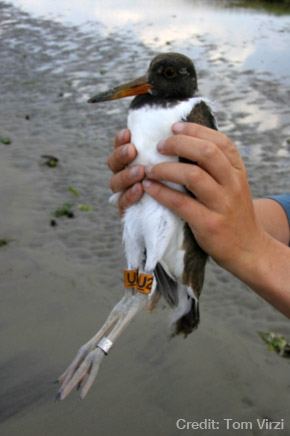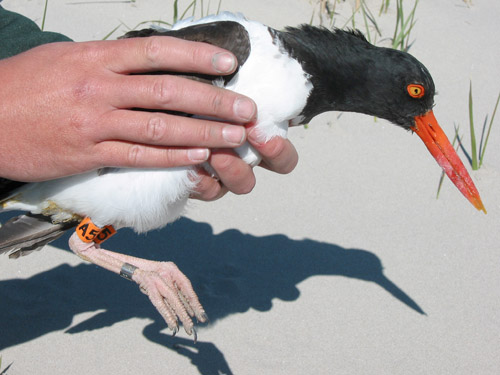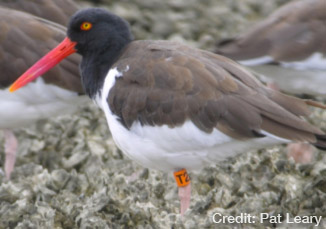
AMOY Research & Monitoring in New Jersey
Research
The Conserve Wildlife Foundation of New Jersey is working to monitor and protect American Oystercatchers. Visit their American Oystercatcher Project website for full information on their work.
Interactive Story Map, “American Oystercatchers Through the Season”
The Conserve Wildlife Foundation of New Jersey (CWFNJ) is proud to release its first interactive GIS-based story map, “American Oystercatchers Through the Seasons“, which brings to life the role New Jersey plays in the breeding, migratory, and wintering cycles of this charismatic coastal species.
A Story Map is a web-based interactive GIS map embedded with multimedia content, such as text, photographs, and video. CWFNJ, working with GIS software developer ESRI and with financial assistance provided by a grant from the New Jersey Division of Fish & Wildlife, plans to make this Story Map the first of many, helping engage the public about New Jersey’s rare wildlife in a dynamic and interactive way.
“American Oystercatchers Through the Seasons” tells the story about a species of migratory bird, the American Oystercatcher, which spends the summer breeding season along the New Jersey coast, but is present year-round along the southern New Jersey coast. Our state represents the northern limit of the species’ winter range. While some New Jersey birds migrate during the winter to Florida, those that breed in New England during the summer may end up spending their winter here in New Jersey.
This Story Map also provides stories about individual banded birds, which have been tracked on journeys between New Jersey and southern states such as Florida, as well as between New Jersey and more northern states, such as Massachusetts.
Variation in American Oystercatcher demography and distribution among natural and man-made islands in coastal New Jersey
The American oystercatcher (Haematopus palliatus) is a species of conservation concern throughout its range due to human encroachment on breeding grounds and high nest losses due to intense mammalian predation. New Jersey holds an estimated 15% of all breeding American oystercatchers in Atlantic and Gulf coast states ranking it among the top five US states in terms of importance for implementing stated recovery goals for the species. Dr. Tom Virzi at Ecostudies Institute is currently evaluating the variation in nest success among natural and man-made islands, which tend to be naturally free of mammalian predators and thus highly productive. Data is being collected that will be used to model island suitability in an effort to identify the key biotic and abiotic variables that influence oystercatcher distribution, density and nest success on these islands.
Demographic data (survivorship, fecundity, etc.) also continues to be collected as part of a long-term mark-recapture study that is being conducted in collaboration with the New Jersey Division of Fish and Wildlife – Endangered and Nongame Species Program and the Conserve Wildlife Foundation of New Jersey. We have been color-banding oystercatchers in New Jersey since 2004; so far over 300 oystercatchers have been color-banded and the effort to increase the marked population continues. While intensive breeding season and winter roost surveys for previously banded oystercatchers are conducted in New Jersey throughout the year, we always appreciate the reporting of any encounters with banded oystercatchers at any season.
Banding
Since 2005, banding of American Oystercatchers in New Jersey has been performed following the protocols established by the American Oystercatcher Working Group. Between 2005 and 2007, we used duplicate “bright” orange darvic bands engraved with 2 black letters/numbers with codes separated by black dots. Since 2008, we have been using duplicate “dull” orange darvic bands engraved with 2 black letters/numbers with the first character underlined (see photo in side gallery for comparison).
NJ Color-Band Fading Issue
The original “bright” orange bands used between 2005 and 2007 have shown signs of substantial fading (see photos). The faded orange bands may look pink or yellow in some light conditions, and thus could easily be confused with yellow-banded oystercatchers from Massachusetts. Special care should be taken when observing any banded oystercatchers that appear to have either orange or yellow bands to ensure accurate reporting. Note that the fading of the “bright” orange bands appears to have stabilized to a pale orange color as of 2011. Additionally, we have not observed any fading of the later “dull” orange bands.
New Jersey Banding Schemes
There may be occasional variation in timing and leg placement of banding schemes.
2004-present: Duplicate orange bands with black horizontal code (two black engraved horizontally-oriented letters/numbers) on upper legs.
Winter 2004: Upper Left leg: Yellow flag with black engraved letters/numbers, Lower Left leg: No band, Upper Right leg: Metal USFWS band, Lower Right leg: Green band.
View Historical Banding Information (PDF).
New Jersey Contacts
- Todd Pover – New Jersey Department of Fish and Wildlife (Endangered and Nongame Species Program) and Conserve Wildlife Foundation of New Jersey
- Tom Virzi – Ecostudies Institute, Mount Vernon, WA
New Jersey Participants
- Conserve Wildlife Foundation of New Jersey
- Edwin B. Forsythe National Wildlife Refuge
- New Jersey Department of Fish and Wildlife – Endangered and Nongame Species Program
- Rutgers, The State University of New Jersey






